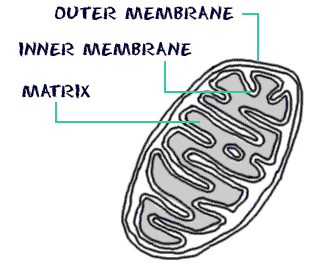
Mitochondria - Turning on the Powerhouse
Mitochondria are known as the powerhouses of the cell. They are organelles that act like a digestive system which takes in nutrients, breaks them down, and creates energy rich molecules for the cell. The biochemical processes of the cell are known as cellular respiration. Many of the reactions involved in cellular respiration happen in the mitochondria. Mitochondria are the working organelles that keep the cell full of energy.Mitochondria are small organelles floating free throughout the cell. Some cells have several thousand mitochondria while others have none. Muscle cells need a lot of energy so they have loads of mitochondria. Neurons (cells that transmit nerve impulses) don’t need as many. If a cell feels it is not getting enough energy to survive, more mitochondria can be created. Sometimes a mitochondria can grow larger or combine with other mitochondria. It all depends on the needs of the cell.
Mitochondria Structure
 Mitochondria are shaped perfectly to maximize their productivity. They are made of two membranes. The outer membrane covers the organelle and contains it like a skin. The inner membrane folds over many times and creates layered structures called cristae. The fluid contained in the mitochondria is called the matrix.
Mitochondria are shaped perfectly to maximize their productivity. They are made of two membranes. The outer membrane covers the organelle and contains it like a skin. The inner membrane folds over many times and creates layered structures called cristae. The fluid contained in the mitochondria is called the matrix.
The folding of the inner membrane increases the surface area inside the organelle. Since many of the chemical reactions happen on the inner membrane, the increased surface area creates more space for reactions to occur. If you have more space to work, you can get more work done. Similar surface area strategies are used by microvilli in your intestines.
What’s in the matrix? It's not like the movies at all. Mitochondria are special because they have their own ribosomes and DNA floating in the matrix. There are also structures called granules which may control concentrations of ions. Cell biologists are still exploring the activity of granules.
Using Oxygen to Release Energy
How does cellular respiration occur in mitochondria? The matrix is filled with water and proteins (enzymes). Those proteins take organic molecules, such as pyruvate and acetyl CoA, and chemically digest them. Proteins embedded in the inner membrane and enzymes involved in the citric acid cycle ultimately release water (H2O) and carbon dioxide (CO2) molecules from the breakdown of oxygen (O2) and glucose (C6H12O6). The mitochondria are the only places in the cell where oxygen is reduced and eventually broken down into water.Mitochondria are also involved in controlling the concentration of calcium (Ca2+) ions within the cell. They work very closely with the endoplasmic reticulum to limit the amount of calcium in the cytosol.
► NEXT PAGE ON CELL STRUCTURE
► NEXT STOP ON SITE TOUR
► RETURN TO TOP OF PAGE
► Or search the sites...
► NEXT STOP ON SITE TOUR
► RETURN TO TOP OF PAGE
► Or search the sites...
Related Video...
Chalk Talk: Mitochondria (US-NSF Video)
Encyclopedia.com:
http://www.encyclopedia.com/topic/mitochondria.aspx#2
Wikipedia:
http://en.wikipedia.org/wiki/Mitochondrion
Encyclopædia Britannica:
http://www.britannica.com/EBchecked/topic/386130/mitochondrion



